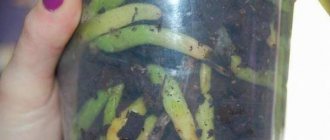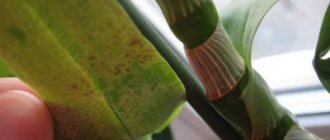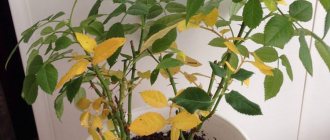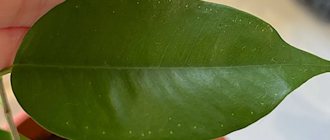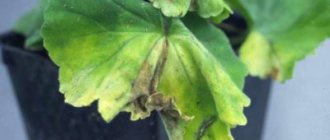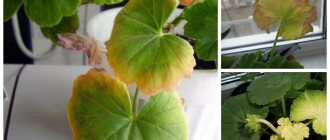Author of the article: Yuliia | Updated: 13-12-2021
Blanket 220x200 cm
1799 ₽ More details
Blanket 220x200 cm
999 ₽ More details
Inexpensive chests of drawers
Most gardeners are faced with various plant diseases and cannot find a solution to the problem. Geranium is no exception and can also be susceptible to many diseases. Are geranium leaves turning yellow and drying out? These are the first signs of plant disease. If you are looking for an answer to the question of why geranium leaves dry out, then perhaps the answer is in the approach to caring for the flower or in the fertilizers used.
Reasons why geranium leaves curl
To begin with, the flower is examined in order to understand the cause of this phenomenon and begin to eliminate it as quickly as possible.
The error can occur at any stage of plant care:
- Wrong choice of soil.
- Poor or excessive watering.
- Incorrect temperature and air humidity.
- Lack or, conversely, excess of fertilizers.
- Damage by pests and viruses.
Improper watering
The condition of geranium leaves directly depends on the amount of moisture received. Trying to retain liquid inside itself, the plant reduces the size of the leaf blade. On average, watering should be done every 3-4 days in the summer, during which time the top layer of soil becomes dry.
You need to water with clean, settled (for 1-2 days) water at room temperature. To soften it, add lemon juice or acid. Per liter 2-3 drops or 1 gram.
Hard water contributes to the accumulation of excess calcium in the soil and causes yellowing.
Excess water also has an adverse effect on the condition of greenery. The leaves change color, their edges dry out, the plant rots or becomes lethargic. To prevent this from happening, when planting, you need to remember about the drainage at the bottom of the pot. Loosening the soil at least once a month will help the roots receive oxygen more easily. And the liquid will better pass into the lower layers of the soil and be discharged through holes in the bottom without stagnation.
In the autumn-winter period, geranium is dormant, so it needs to be watered less often, 2-3 times a month. If the plant nevertheless begins to shed leaves and the roots rot, the solution would be to remove the damaged roots and completely replace the soil in the pot.
Soil selection, errors in fertilizing
For planting, you can buy special or universal soil in the store. Or compose it yourself.
The main condition is that the soil should not be hard and heavy, the flora should be neutral or slightly acidified. Mandatory components are sand and peat.
As the soil depletes, mineral fertilizers are applied. Particular attention is paid to nitrogen, which is responsible for the formation of greenery and abundant flowering. The leaves will be the first to signal its deficiency by becoming thin, yellow and faded.
Also, a change in color may be due to:
- Boron deficiency.
- Calcium deficiency.
- Lots of potassium.
Excess fertilizing is also harmful, so it is necessary to choose the right fertilizers and carefully measure the doses indicated in the instructions for the drug. Optimal schedule: once every 2 weeks.
If the plant was recently transplanted, it needs to be fed after two months.
Some gardeners plant geraniums in open ground in the summer. In the fall, when transferring to a pot, it is better not to take soil from the garden bed, in order to avoid infection by fungus or pests. It is optimal to purchase ready-made soil in a store.
PELARGONIA: OTHER DISEASES AND ERRORS IN CARE
Geranium leaves indicate the health of the entire plant. This is a kind of indicator that can indicate possible diseases of pelargonium, incorrect watering and fertilizing patterns. There are some specific “symptoms” that can tell you a lot.
THE EDGES OF GERANIUM LEAVES DRY
If the edges of the leaf blades of a geranium begin to dry, there may be two reasons for this condition:
LEAVES TURN INWARDS
If the leaves of pelargonium begin to curl inward, this may be evidence of an imbalance of mineral substances. This condition is caused by a lack of nitrogen or excess potassium. Nitrogen in large quantities is only needed during the growth stages of the plant, so the leaves of young plants often curl. To prevent deficiency or oversaturation of elements, it is recommended to use ready-made complex mineral fertilizers for flowering plants: they contain substances in the required proportions.
Often the cause of leaves curled at the edges is pests. Most often - spider mites. To detect it, you need to examine the leaf blades of pelargonium from all sides. It is advisable to use a magnifying glass. Ticks can be easily treated with chemicals - insecticides. Several treatments may be required.
Viral infection is much more dangerous. With it, the inflorescences take on a clumsy, ugly shape. In this case, it is unlikely that it will be possible to save the geranium. It should be thrown out of the house to prevent the infection from spreading to other indoor plants.
HOW TO TRANSPLANT GERANIUM (VIDEO)
PELARGONIA WILLS IN A POT
If a geranium withers in a pot and slowly dies, then the reason lies in root rot. This disease can easily destroy a plant. Such pelargonium is usually thrown away, cutting off healthy cuttings for further rooting. The instruments must then be disinfected. To avoid root rot, you should try not to overwater the plant and ensure good drainage.
GERANIUM LEAVES TURN BLACK
WHITE POINT ON THE PLANT
White bloom on geraniums is a sign of spider mites. To get rid of it, you need to remove the parasites from the plant, and then treat it with a special composition: a solution of an acaricidal agent.
THE LEAVES ARE SHALLOWING
Pelargonium leaves inevitably become smaller with age. If the plant is too old, then its freshest shoots should be cut off for further rooting. Other causes of small leaves in pelargonium may be:
Incorrect conditions of detention
Due to incorrect humidity and temperature indicators, short daylight hours, tight or too loose containers, the leaf plate changes its shape or color.
Lighting
Pelargonium loves well-lit window sills. But it needs to be shaded from direct sunlight, because of which the leaves will get burned. In the winter-spring period, on the contrary, the flower is placed in the sunniest place.
Temperature
In autumn and spring, it is better to keep pelargonium on a glazed balcony. The main maintenance condition is that the air should not be very cold +10…+12 °C.
Optimal indicators:
| Season | Temperature |
| Summer | +20…+25 °C |
| Winter | No more than +14 °C |
Humidity
Geranium does not tolerate air dried out by heating devices. To avoid leaf falling, it is better to purchase a humidifier or use a spray bottle. But you need to spray the liquid not on the plant, but at some distance from it. A container of water or wet expanded clay placed nearby will also solve the problem.
It is better to place the pots away from radiators and ventilate the room once a day. But this must be done carefully, because the plant does not like drafts. It also loses moisture from the surface of the leaves, causing them to curl.
Tight pots
The container in which pelargonium grows should not be small. If the roots become crowded, this will affect the appearance of the foliage. It will begin to dry out and lose color. If the pot is large, then the forces will be directed to the growth of the root system, but the flowers will not appear soon.
A plant planted in a container that is not the right size is replanted. This must be done carefully, because yellowing of the foliage can be caused by damage to the roots.
If the pot is changed during the flowering period, the flower stalks are removed.
Pests and diseases
Geranium is rarely affected by pests due to the bitterness of the juice, but there are those that still settle on the stems and greens. For example, a spider mite, it can be seen with a magnifying glass on the back of the leaves, which are covered with a transparent cobweb, dry and curl inward.
Two more dangerous parasites: whiteflies and aphids, which feed on sap. The drug Marathon or folk remedies (solutions of onions, tomato or potato tops) help fight them. You can prepare an infusion from a head of garlic and a liter of boiling water, let it sit for a week, dilute it with water at the rate of 50 grams per 10 liters and spray the leaves.
To cope with these pests, it is necessary to treat the plant with an insecticide. For example, Akarin, Fitoverm, Molniya, Vertimek. It is better to do this several times at intervals of 5-7 days.
And they are also affected by viral diseases, for example, leaf bacteriosis. Characteristic signs will be not only curling leaves, but also brown spots resembling a mosaic. Wilting even affects the stems. It is impossible to cure such an infection, so it is better to dispose of the flower in order to preserve the health of the plants around it.
If the root system is damaged by rot, when replanting, treat with a solution of potassium permanganate of medium concentration, pink color, for 15-20 minutes. For disease prevention, once every six months and as a top dressing no more than once every 14 days. When pouring crystals into water, it is difficult to calculate the grams and focus better on the resulting color of the solution.
Flower pests
The appearance of yellowness can also be caused by the appearance of pests of geraniums.
Root mealybug
When the soil is over-moistened, a pest such as a root worm may appear in the roots of geraniums. A small yellow leaf, cessation of normal growth and development of the plant is its manifestation. Harmful insects cannot be seen on the soil surface. Therefore, to get rid of them, the diseased plant must be removed from the pot and completely freed from the soil, rinsed in water. After carefully examining the root system, the roots damaged by the scale insect are removed. Then the roots are immersed in hot water, dried and treated with charcoal. You cannot use the same soil for planting! The plant needs to be replanted using a special soil mixture.
Aphid
Living in colonies, aphids can also cause geranium leaves to turn yellow and dry out. Having seen aphids on the back of the leaf, the plant is mechanically processed and all leaves, as well as buds, are removed. To prevent the reappearance of aphids, the flower is treated using the drug Fitoverm according to the instructions.
Having found out why geranium leaves turn yellow, you can provide the plant with timely help, allowing the geranium to remain a symbol of your cozy home all year round.
Who knows why geranium leaves turn yellow? - Of course, experienced flower growers! And even beginners, if they are really interested in this plant, decide to plant it at home. In scientific circles, geranium is better known as Pelargonium, and in England it is called the “poor man's flower” due to its popularity among the lower classes. But if we put noble snobbery aside, geranium has every right to be considered a luxurious flower, pleasing with its beauty and medicinal properties.
Mr. Summer Resident advises: how to avoid curling of geranium leaves
It is much easier to prevent a dangerous disease than to fight it. Therefore, the main advice will be prevention.
Measures to prevent curling and yellowing of leaves:
- Regular but not intensive watering.
- Mandatory plant inspection and pest control.
- Optimal temperature and humidity indicators.
- Comfortable and cool wintering. Regular ventilation of the room.
- Timely feeding. Strictly follow the instructions and adhere to the doses indicated on the drug labels.
- Choosing a suitable pot and a bright window sill without direct sunlight.
- In the warm season, take it out into the fresh air.
By following the recommendations and creating optimal conditions for growth, even a beginner will grow healthy pelargonium at home, which will delight you with abundant flowering and caps of dense greenery. After all, a strong plant is much less susceptible to viruses and pest attacks.
Diseases, their photos, treatment and prevention
To overcome diseases that are common in geraniums, you need to identify and eliminate them in a timely manner:
- If it is noticed that the plant has withered, it is necessary to immediately remove diseased areas, dry leaves and branches.
- The flower bed where the plant is planted for the summer must be constantly cleared of weeds.
- You cannot water geraniums by overhead watering and after 11 a.m.
- When processing a plant, it is necessary to wash your hands more often.
- Do not add fertilizers that contain a lot of nitrogen to the soil.
- The soil must have good drainage so that water does not stagnate in it.
- We need to fight insects.
- Many diseases are treated with chemicals that contain a fungicide (antifungal substance).
Blackleg
This disease develops due to waterlogged soil or lack of drainage. As a result, the stem darkens and rots. To prevent the development of the disease, it is necessary to pinch off the cuttings and cut off the top, then root.
Rhizoctonia rot
Dark spots form at the bottom of the stems. There is no flowering. As the disease progresses, the leaves turn yellow and wither, and the plant dies. The infection penetrates through the soil.
Provoke the development of the disease:
- Excess fertilizer.
- Warmth in the room, especially during the heating season.
- Excessive soil moisture.
- Poor lighting and poor ventilation.
Help with illness:
- Use quality soil.
- Temporarily stop watering.
- Treatment of the plant with such preparations as Vitaros, Fundazol, Rovral.
Our experts have prepared materials for you about diseases of geranium leaves, as well as the reasons why they turn white, red and curl.
How to prevent the problem?
In order to prevent the appearance of wilted leaves, you should eliminate all negative factors , re-read the basic rules for caring for geraniums, and set up an orderly schedule for watering and feeding the plant. After all, coping with diseases and their consequences is not always easy. It's better not to let this happen.
When you correctly follow the above instructions and devote more time to your favorite indoor plant, then geranium will delight you for a long time with lush, juicy foliage and bright flowers. And the aroma will calm her down and set everyone in the household positive.
The plant has little green part
Geranium is not a whimsical plant, but despite this, it can react to improper care.
Why does this happen?
Many flower growers with extensive experience know firsthand that geraniums take on an unattractive appearance not only from various diseases, but also from improper maintenance.
This is what happens - the stems stretch out and there are very few leaves left on them. Very often, beginning flower growers observe this phenomenon in winter.
But you shouldn’t immediately throw the plant in the trash bin - the flower can and should be saved. It is enough to simply place the flowerpot in the sunlight, while pre-trimming the elongated shoots to the desired height.
In addition, the flower must be rotated periodically so that it is even and lush. If even after these manipulations, the plant stops growing and stops producing new leaves, then measures need to be taken.
What to do?
First of all, the plant is carefully examined for the presence of insects and diseases. If neither one nor the other could be identified, then it’s a matter of fertilizing and soil acidity. You can do this as follows:
- Replant the plant by changing the soil. This should be done with special care so as not to damage the roots of the plant, otherwise it will take a very long time to recover.
- Carry out constant feeding, and you can use not only purchased complexes, but also folk remedies. For example. When replanting, use egg shells as drainage.
Too much light
You may be interested in: Billbergia drooping: description with photos, conditions of maintenance and care
It would seem that the reason is rather strange, because everyone needs light. But it is important to distinguish between the effects of warm spring sun and scorching summer heat. Geranium is a fairly heat-loving plant, but it will not withstand constant heat. If the flower is exposed to the sun for a long time, the leaves will certainly turn yellow and curl.
In this case, the simplest thing you can do is move the plant to a more shaded place. It also happens that a flower begins to suffer in winter, when there is very little sunlight. This is due to space heating. After all, very often flowers in pots stand on the windowsill above the radiator, which is precisely the source of hot and dry air. In this case, also take care to move the plant away from the hot radiator.
